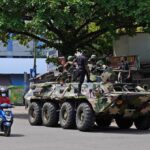
Russian President Vladimir Putin appears to be preparing for “a prolonged conflict” in Ukraine will likely become “more unpredictable and escalatory” in coming months, largely because “Putin faces a mismatch between his ambitions and Russia’s current conventional military capabilities,” U.S. Director of National Intelligence Avril Haines told a Senate committee on Tuesday.
Putin aims “to achieve goals beyond the Donbas,” up to carving a land bridge along Ukraine’s Black Sea coast to the Russian-aligned breakaway Transnistria region of Moldova, Haines said. Putin is highly unlikely to achieve that last goal, which would damage Ukraine’s economy immensely, without a full mobilization inside Russia, a step he hasn’t taken.
The 75-day conflict has turned into a war of attrition, and “as both Russia and Ukraine believe they can continue to make progress militarily, we do not see a viable negotiating path forward, at least in the short term,” Haines said. For his part, Putin “is probably counting on U.S. and E.U. resolve to weaken as food shortages, inflation, and energy shortages get worse.”
The House, hours after her testimony, voted 368-57 to approve nearly $40 billion in military and humanitarian aid to help Ukraine fend off Russia plus other measures to ease the fallout. The Senate will likely pass the bill this week.
Haines said that as the war grinds on, Putin may turn to “more drastic means” but he’s unlikely to use nuclear weapons unless he sees an “existential threat” to Russia or his rule. Lt. Gen. Scott Berrier, the head of the Defense Intelligence Agency, agreed about the low risk of nuclear warfare and told the Senate that eight to 10 Russian generals have been killed while fighting in Ukraine, an extraordinary high number of senior officers in a very short amount of time.
You may also like
Biden announces free internet for millions of low-income Americans
Nepali mountaineer breaks his own world record on Mount Everest




